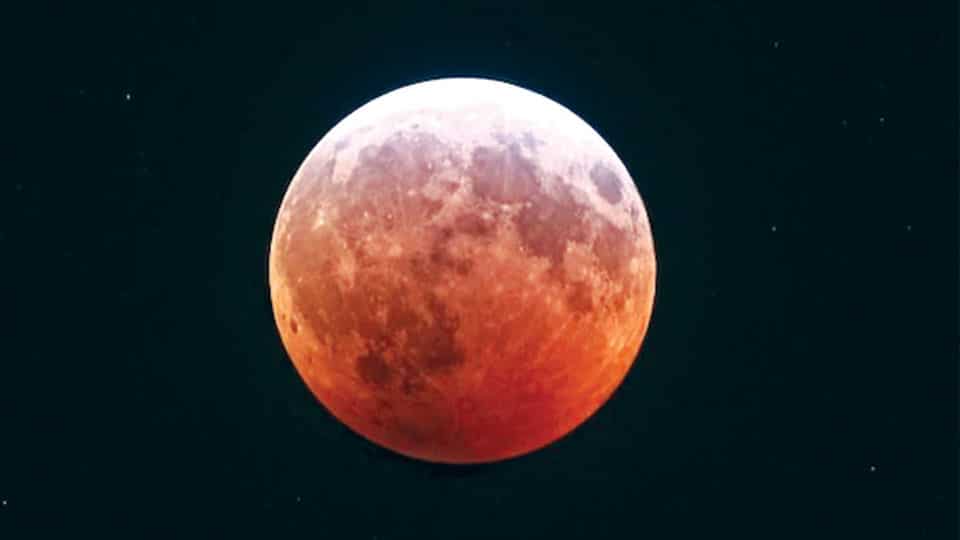By Dr. S.A. Mohan Krishna, Amateur Astronomer
COVID, Black Fungus everywhere… People have forgotten everything, instead become restless with maximum fear in them. But on May 26, people can forget everything and witness a spectacular Blood Flower Supermoon Penumbral/ Partial Lunar Eclipse after 6.40 pm.
The most effective, amazing, gorgeous, memorable and evident astronomical event in the sky is an ‘Eclipse’. None can forget the mesmerising Supermoon, Bloodmoon Total Lunar Eclipse that occurred on January 31, 2018! In the same way, on July 27-28, 2019 Indians were really privileged to witness a regular longest duration ‘Total Lunar Eclipse’ of this century. But this year, Mysureans shall be happy to witness a rare celestial feast, Blood Flower Supermoon Penumbral Lunar Eclipse on May 26, since it is visible from most of the parts of India for a short span. This Eclipse will be visible in the region covering South America, North America, Asia, Australia, Antarctica, Pacific and Indian Oceans.
Partial or Penumbral Lunar Eclipse is not a mesmerising astronomical event, since it occurs every year. But on the same day, one can see to Blood Supermoon, the biggest and brightest Full Moon of the year. On that day, the distance between Moon and Earth will be 3,57,365 kilometres. On May 26, 2021, the Full Moon will sweep through the Earth’s dark Umbral shadow, creating a Total Eclipse of the Moon. This May Full Moon is 2021’s closest (and therefore biggest and brightest) Full Moon of the year: a Supermoon. This particular Eclipse is special because the totality, or total phase, is so short-lived, lasting less than 15 minutes. The Full Moons of July, August, September and October 2021 will all travel south of the Earth’s shadow. Finally, the November 2021 Full Moon will meet up with the Earth’s dark shadow on November 19, 2021. It won’t be a perfect alignment, however, and the November Full Moon will just miss being totally eclipsed.
Lunar Eclipses, which may be Total or Partial, can occur only at Full Moon when Sun, Earth and Moon are in line. As the Sun is an extended light source, Earth’s shadow has two components — a dark, central Umbra, where the Sun is completely obscured, and a lighter outer Penumbra, within which the obscuration is partial. During a Lunar Eclipse, the Moon passes first through the Penumbra, taking about an hour, moving eastward by its own diameter in this time, to reach the western edge of the Umbra. A Lunar Eclipse occurs when the Moon passes through the Umbral region of the Earth’s shadow and becomes imperceptible. Lunar Eclipse is discernible from a large part of the Earth. On May 26, at Mysuru, the beginning and middle phases will not be discernable but the ending phase of the Penumbral Eclipse will be visible. The Eclipse shall be perceptible from Mysuru from 6.45 pm to 7.19 pm, for about 34 minutes.
The total duration of the Total Lunar Eclipse visible from other parts of the globe on May 26 is 5 hours 14 minutes, but at Mysuru it will be a Penumbral Lunar Eclipse. The magnitude of the Partial Eclipse of the Moon is 0.444. There is absolutely no harm in witnessing this gorgeous astronomical spectacle and could be clearly witnessed by using a reflecting telescope or astral binoculars. Following first contact, the Moon’s more easterly limb will show a growing dark “nick” as it begins to enter the Umbra more deeply.
At a Total Lunar Eclipse, Moon takes about an hour to become completely immersed in the Umbra. To begin with, there is little to see beyond a darkening of part of the Moon, but as the eclipsed portion increases, some colour may become evident. The curved edge of the Umbra may show a slight blue fringe. Refraction of Sunlight — particularly at the red end of the spectrum — through Earth’s atmosphere means that the Umbra is not completely dark. Consequently, the Moon does not usually disappear from view; instead, it is dimmed and often takes on a reddish colour, which becomes increasingly apparent as the Umbral phase advances.
At Mysuru, the best viewing location is from Chamundi Hill. After this year, the next time that a Blue Moon passes through Earth’s Umbra will be on Dec. 31, 2028, and, after that, on Jan. 31, 2037. Both of these eclipses will be total. Large telescopes or high magnifications are of little value for observing a Lunar Eclipse. It is always recommended using binoculars or a small low-power telescope, since they both allow the entire Moon to be viewed during the event. Enjoy the rare celestial feast.








Recent Comments